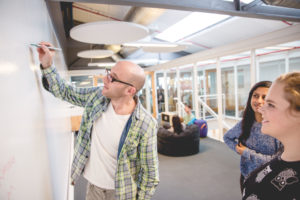
Ambiguity – The Secret Sauce for Success
Posted on February 24, 2019
“I wanted a perfect ending. Now I’ve learned, the hard way, that some poems don’t rhyme, and some stories don’t have a clear beginning, middle, and end. Life is about not knowing, having to change, taking the moment and making the best of it, without knowing what’s going to happen next. Delicious Ambiguity.” — Gilda Radner
Male or Female. Black or White. Left or Right. Up or Down.
Tolerance of Ambiguity (TOA)

Ambiguity can be uncomfortable. I, for one, like to know that I am doing things “correctly”. When I take a class, even when directed to do a fun activity, I have this urge to make sure I’m doing it “right”. Similarly, in assignments, if the instructions are vague, I feel anxiety. How can I know exactly what the teacher wants? As a mom, how do I handle tantrums in the right way? Food refusals? Teenager hygiene (blech). Somebody tell me the answer!
The conditioning since kindergarten on having a “right” and “wrong” answer does not set us up for lifelong success, let alone encourage innovation. But it goes much deeper than innovation and creativity – to the very core of our mental fitness.
In our instant gratification “google it” lifestyle, not knowing the answer (or that a correct answer even exists) is stressful.
Tolerance of Ambiguity, or TOA, is a measure used in psychology to quantify an individual’s comfort with shades of gray, ambiguity (obvy!) and uncertainty. Based on the research into TOA, tolerance of ambiguity is a marker of desirable traits in the workplace.
TOA can be hard to study, because, well, it can be a bit of an ambiguous assessment.
Studies on Tolerance of Ambiguity (TOA)
Recently, Fewster and O’Connor looked at tolerance of ambiguity among a number of different dimensions. They examined TOA within the specific context of a workplace setting. They found three main dimensions to be associated with Tolerance of Ambiguity:
-
- Desire for Challenging Work
- Comfort with Ambiguity
- Coping with Uncertainty

In their report, Fewster and O’Connor describe 8 habits to increase your Tolerance of Ambiguity
- Master Mindfulness
- Be Assertive
- Focus on What Matters
- Practice Agility
- Cultivate Curiosity
- Act Courageously
- Let Go and Move On
- Think Differently
If you are curious about how you might incorporate some of these 8 habits into your life, keep reading below, and you can read the full paper here.
Creativity and Ambiguity
Being creative – in any way – can help you to face uncertainty, learn how to manage ambiguity, and face failure. When have you ever confidently launched a creative project with confidence? Did you ever start a painting thinking it was going to be the next Mona Lisa? Being creative is highly linked to TOA. Creativity is diverse. Painting, drawing, stand up comedy, knitting, writing, scrapbooking, photography and more. Also, being creative covers many of the 8 habits in the list; be assertive (just pick a paint colour already!), practice agility (delete the last 2 pages and start again), cultivate curiosity (I wonder how this shot will look with the light coming from the side), act courageously (tell that joke onstage), let go and move on (so what if you hate my painting…pffft), and think differently (change the spreadsheet slightly and reap immediate rewards in productivity).
Stress and Ambiguity
Perhaps we can blame some of our increasing anxiety and stress on having all the information at our fingertips. Before smartphones, to find an “answer” meant hours at the library on a card catalogue. Or, driving 4 hours to interview an expert. Better yet, scanning the microfiche to find the 5 articles on a topic. And, shockingly, sometimes you just had to go with a decision based on your experience, and what you knew at the time.
These days, if you want to know the life cycle of the tapeworm? Google has the answer, and watch a meme for fun. Searching for statistics on the number of people who were killed by lightning last year in Canada? Siri can tell you while you are driving. Consequently, if we have no practice in handling ambiguity when it doesn’t matter, how do we expect to perform when it does?
I have started to look for ways that I might increase TOA in my kids. I want to help them to weather the storms of uncertainty and anxiety as they grow up. As Sigmund Freud says “Neurosis is the inability to tolerate ambiguity”. So, if I have any part to play in how neurotic my kids are, then I’m going to try my best to keep them, well, as close to the opposite of neurotic as possible. (As a good 21st century citizen, I am going to cherry pick which of Freud’s theories and quotes I choose to believe).
Job Skills linked to Ambiguity
 Certainly, we need to regain our ability to progress, despite uncertainty. But don’t confuse comfort with uncertainty for ignorance. Data, statistics and the scientific method are still critical. But in most of life’s situations, there is no peer-reviewed study, working group or t-test to tell you black from white. Also, if we foster an ability to be comfortable with ambiguity, we also foster greater creativity, resilience, and complex problem solving skills. (Fewster and O’Connor). Since the World Economic Forum identified Complex Problem Solving as the #1 skill required by employers in both 2015 and 2020, with Creativity a close #3, I know I’m going to start throwing my kids (and myself) more ambiguous curve balls.
Certainly, we need to regain our ability to progress, despite uncertainty. But don’t confuse comfort with uncertainty for ignorance. Data, statistics and the scientific method are still critical. But in most of life’s situations, there is no peer-reviewed study, working group or t-test to tell you black from white. Also, if we foster an ability to be comfortable with ambiguity, we also foster greater creativity, resilience, and complex problem solving skills. (Fewster and O’Connor). Since the World Economic Forum identified Complex Problem Solving as the #1 skill required by employers in both 2015 and 2020, with Creativity a close #3, I know I’m going to start throwing my kids (and myself) more ambiguous curve balls.
Share in the comments what you do to keep your mind fresh, and how you stay comfortable in the face of ambiguity;
Follow me for more ideas on Facebook – www.facebook.com/artfulsciencepro
or Instagram – www.instagram.com/artfulscience
Finally, If you are in Calgary, please join me at one of my free or paid events for Creative Resilience. We will test your comfort zone – but in a fun, no stress way in a safe environment.You can view a schedule and read more details here, or send me an email to hello@carolinebrookfield.com for more info.
Or, if you feel like practicing facing ambiguity — just find another way to contact me. You’ll figure it out.